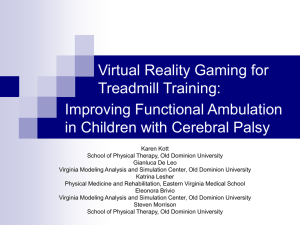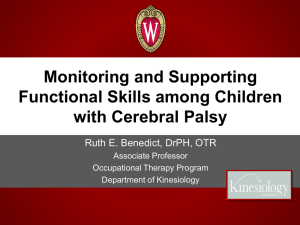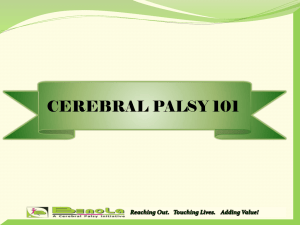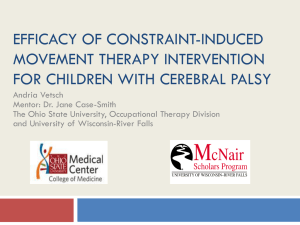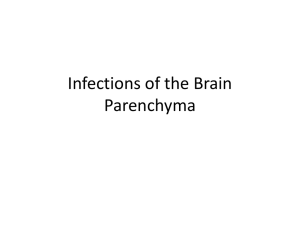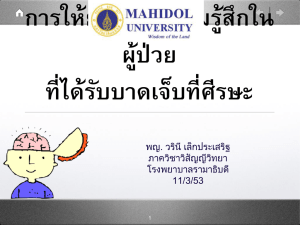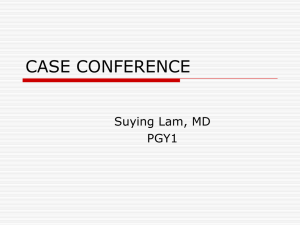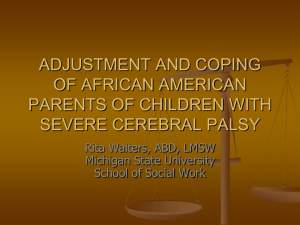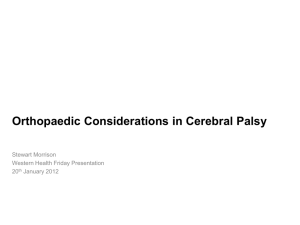Non-spastic cerebral palsy
advertisement
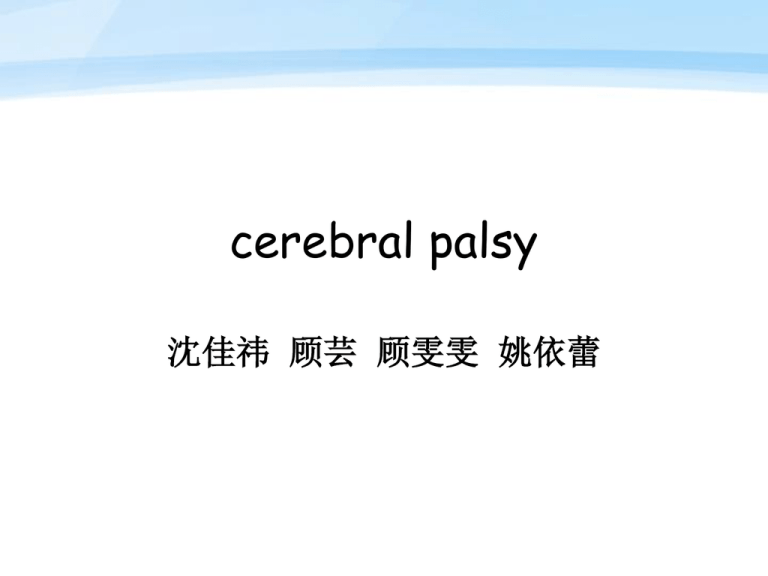
cerebral palsy 沈佳祎 顾芸 顾雯雯 姚依蕾 Topics • • • • • • Definition Causes Types & forms symptom Diagnosis Therapy definition Definition • Cerebral palsy (CP) is an umbrella term encompassing a group of non-progressive, non-contagious motor conditions that cause physical disability in human development, chiefly in the various areas of body movement. causes Causes • It is caused by damage to one or more specific areas of the brain, usually occurring during fetal development or infancy. • It also can occur before, during or shortly following birth. Causes Brain Injury or Brain Periventricular Leukomalacia (PVL)脑室周围白质软化 Malformation 脑损伤和脑畸形: Cerebral Dysgenesis脑发育障碍 Lack of oxygen to the brain or asphyxia缺乏大脑缺 母亲生产 氧或窒息 生产前:孕怀时期母体感染、放射线 Intracranial Hemorrhage颅内出血 受伤、发烧、感染、脑部外伤、全身疾病、 过度照射、药物中毒、子宫或胎盘功能 核黄疸:由于胆红素沉积在基地神 黄疸等。 不好、先天性异常,或母亲疾病、代谢、 经节、脑干神经核而引起的脑损害。 内分泌异常、受伤等。 核黄疸可能导致手足徐动型脑瘫, 生产时:早产、缺氧、产伤、(产钳或 对脑组织损害较大。 真空吸取)、多胞胎、胎儿窘迫、脐带绕 出生后各种脑部、脑外伤及全身疾 颈等。 病:常见的病因有脑膜炎、脑炎或 全身重症感染所致的脑病,脑外伤 所致的颅内出血,一氧化碳中毒引 起的脑缺氧等,都可能引起脑瘫。 Types & forms Types & forms Classification by Severity level Topographical distribution Motor function Gross motor function classification system Using motor function gives parents, doctors, and therapists a very specific, yet broad, description of a child’s symptoms, which helps doctors choose treatments with the best chance for success. Severity level • Mild - Mild cerebral palsy means a child can move without assistance; his or her daily activities are not limited. • Moderate - Moderate cerebral palsy means a child will need braces, medications, and adaptive technology to accomplish daily activities. • Severe - Severe cerebral palsy means a child will require a wheelchair and will have significant challenges in accomplishing daily activities. • No CP - No CP means the child has cerebral palsy signs, but the impairment was acquired after completion of brain development and is therefore classified under the incident that caused the cerebral palsy, such as traumatic brain injury. Topographical distribution Paresis means weakened Plegia/Plegic means paralyzed The prefixes and root words are combined to yield the topographical classifications commonly used in practice today. • Monoplegia/monoparesis means only one limb is affected. It is believed this may be a form of hemiplegia/hemiparesis where one limb is significantly impaired. affected diplegic more • Diplegia/diparesis usually indicatesseverely the legs are affected child may be inability to than the arms; primarily affects the lower body. pronounce/s/, /th/, /l/, or /r/ • Hemiplegia/hemiparesis indicates the arm and leg on one side of the body is affected. • Paraplegia/paraparesis means the lower half of the body, including both legs, are affected. Topographical distribution continued • Triplegia/triparesis indicates three limbs are affected. • Double hemiplegia/double hemiparesis indicates all four limbs are involved, but one side of the body is more affected than the other. • Tetraplegia/tetraparesis indicates that all four limbs are involved, but three limbs are more affected than the fourth. Quadriplegia/quadriparesis means that all four limbs are involved. • Pentaplegia/pentaparesis means all four limbs are involved, with neck and head paralysis often accompanied by eating and breathing complications. Gross motor function classification system • GMFCS Level I- walks without limitations. • GMFCS Level II- walks with limitations. • GMFCS Level III- walks with adaptive equipment assistance. • GMFCS Level IV- self-mobility with use of powered mobility assistance. • GMFCS Level V- severe head and trunk control limitations. Motor function Spastic cerebral palsy (Pyramidal) Non-spastic cerebral palsy (Extrapyramidal) Ataxic 共济失调 Mixed Dyskinetic 不随意运动 Athetoid手足徐动型 Dystonia低张型 Motor function • Spastic cerebral palsy is characterized by increased muscle tone. • Non-spastic cerebral palsy will exhibit decreased or fluctuating muscle tone. Motor function Spastic (Pyramidal) • increased muscle tone. – limbs stiff, rigid, and resistant to flexing or relaxing. – Reflexes can be exaggerated, while movements tend to be jerky and awkward. • The tongue, mouth, and pharynx can be affected,impairing speech, eating, breathing, and swallowing. Motor function continued Non-Spastic (Extrapyramidal) • be decreased and/or fluctuating muscle tone. • involuntary movement(无意识运动) • Movement can be slow or fast, often repetitive, and sometimes rhythmic. Motor function continued • Non-spastic cerebral palsy is divided into two groups – Ataxic (共济失调) – Dyskinetic(不随意运动) Motor function continued Ataxic cerebral palsy • affects coordinated movements协调运动( Balance and posture are involved) • Walking gait is often very wide and sometimes irregular. • Control of eye movements and depth perception can be impaired. – fine motor skills requiring coordination of the eyes and hands. Motor function continued Dyskinetic cerebral palsy • Athetoid cerebral palsy includes cases with involuntary movement, especially in the arms, legs, and hands. • Dystonia/Dystonic cerebral palsy encompasses cases that affect the trunk muscles more than the limbs and results in fixed, twisted posture. Motor function continued • non-spastic cerebral palsy is predominantly associated with involuntary movements • Athetosis(手足徐动) — slow, writhing movements that are often repetitive, sinuous, and rhythmic • Chorea (舞蹈病)— irregular movements that are not repetitive or rhythmic, and tend to be more jerky and shaky • Choreoathetoid — a combination of chorea and athetosis; movements are irregular, but twisting and curving • Dystonia(肌张力不全) — involuntary movements accompanied by an abnormal, sustained posture • Ataxia/Ataxic(共济失调) — does not produce involuntary movements, but instead indicates impaired balance and coordination Motor function continued • Mixed: A child’s impairments can fall into both categories, spastic and non-spastic, referred to as mixed cerebral palsy. The most common form of mixed cerebral palsy involves some limbs affected by spasticity and others by athetosis. Motor function continued 2002年欧洲脑瘫监测组织(Surveillance of Cerebral Palsy in Europe,SCPE)推荐脑瘫临床树状分型法 欧洲脑瘫监测组织脑瘫树桩分型法 Signs and symptoms What’s the difference between Sign and Symptom? • Signs are clinically identifiable effects of brain injury or malformation that cause cerebral palsy. • Symptoms, on the other hand, are effects the child feels or expresses; symptoms are not necessarily visible. Symptom Sign VS • taken on the whole, CP symptomatology is very diverse. The effects of cerebral palsy fall on a continuum of motor dysfunction which may range from slight clumsiness at the mild end of the spectrum to impairments so severe that they render coordinated movement virtually impossible at the other end the spectrum. • Impairments resulting from cerebral palsy range in severity, usually in correlation with the degree of injury to the brain. Because cerebral palsy is a group of conditions, signs and symptoms vary from one individual to the next. 婴儿时期 频繁吐沫 非常"敏 感"或"激 动 小儿时期 视、听觉障 口、面功 言语障碍 碍 能障碍 喂养困难,吸 吮及吞咽不协 调 Signs and Symptoms • 1. Abnormal muscle tone • 2. Joint and bone deformities and contractures • 3. Developmental delay • 4. Speech and language disorders 1. Abnormal muscle tone • The primary effect of cerebral palsy is impairment of muscle tone. e.g. slouching over while sitting. 2. Joint and bone deformities and contractures • The classical symptoms are spasticities, spasms, other involuntary movements (e.g. facial gestures), unsteady gait, problems with balance, and/or soft tissue findings consisting largely of decreased muscle mass. • Scissor walking (where the knees come in and cross) Toe walking (which can contribute to a gait reminiscent of a marionette) are common among people with CP who are able to walk. 3. Developmental delay • Babies born with severe CP often have an irregular posture; their bodies may be either very floppy or very stiff. Symptoms may appear or change as a child gets older. Some babies born with CP do not show obvious signs right away. Classically, CP becomes evident when the baby reaches the developmental stage at six and a half to nine months and is starting to mobilise, where preferential use of limbs, asymmetry(不对称) or gross motor developmental delay is seen. 3. Developmental delay • In moderate to mild cases of cerebral palsy, parents are often first to notice if the child doesn’t appear to be developing on schedule. • Delay in reaching key growth milestones. such as: • • • • Rolling over Sitting Crawling Walking • signs such as unusual posture, persistent infant reflexes, and early development of hand preference should also be concerned. 4. Speech and language disorders • Speech and language disorders are common in people with cerebral palsy. The incidence of dysarthria is estimated to range from 31% to 88% • Speech problems are associated with poor respiratory control, laryngeal and velopharyngeal(腭咽) dysfunction as well as oral articulation disorders that are due to restricted movement in the oral-facial muscles. There are three major types of dysarthria in cerebral palsy: spastic(痉挛麻痹), dyskinetic (运动困难) and ataxic(运 动失调). spastic spasticity, weakness, limited range of motion and slowness of movement. dyskinetic disorder in the regulation of breathing patterns, laryngeal dysfunction (monopitch, low, weak and breathy voice quality). It is also associated with articulatory dysfunction (large range of jaw (颌) movements), inappropriate positioning of the tongue, instability of velar elevation. Ataxic Ataxic dysarthria is uncommon in cerebral palsy. Overall, language delay is associated with problems of mental retardation (迟钝), hearing impairment and learned helplessness. Children with cerebral palsy are at risk of learned helplessness and becoming passive communicators Early intervention often targets situations in which children communicate with others, so that they learn that they can control people and objects in their environment through this communication, including making choices, decisions and mistakes. • People with CP tend to be shorter in height than the average person because their bones are not allowed to grow to their full potential. Sometimes bones grow to different lengths, so the person may have one leg longer than the other. • 近视或斜视,其中以内斜视为多见,听力减退 以徐动型脑瘫较为多见 • 听力,对声音的节奏辨别存在困难 • 脸部肌肉和舌部肌肉均出现明显痉挛或不协调 收缩,咀嚼和吞咽困难,口腔闭合困难以及流 口水。 • 对外界的反应较平淡由于肌张力低下,抗重力 能力和维持某种姿势的能力变弱,患儿头部、 躯干的上拾,四肢的支撑均变得困难,所以这 类患儿多喜欢采用仰卧位。 • Many signs and symptoms are not readily visible at birth, except in some severe cases, and may appear within the first three to five years of life as the brain and child develop. Most experts agree; themade earlier a cerebral • If a diagnosis can be early on, early palsy diagnosisprograms can be made, better. intervention andthe treatment protocols have shown benefit in management of cerebral palsy. • Early diagnosis also helps families qualify for government benefit programs and early intervention. Diagnosis Diagnosis诊断 How is the diagnosis made? first few months,a variety of symptoms can suspect •Lethargy, or lack of alertness 嗜睡,或缺乏警觉性 •Irritability or fussiness 易怒或烦躁 •Abnormal, high-pitched cry 异常、高音调的喊叫 •Trembling of the arms and legs 手足颤栗 •Poor feeding abilities secondary to problems sucking and swallowing 进食能力差继发吸吮和吞咽问题 •Low muscle tone 肌张力低下 •Abnormal posture, such as the child favoring one side of the body 异常姿势,如孩子倾向身体一侧 •Seizures, staring spells, eye fluttering, body twitching 癫痫,直瞪,眼神飘忽,身体抽搐 •Abnormal reflexes.异常反射 Page 40 During the first 6 months of life, other signs also appear in an infants muscle tone and posture(肌张力和 姿势). These signs include: •Muscle tone change from low tone to high tone; go from floppy to very stiff.(肌张力低下到肌张力高:由懒散变得僵硬) •hold his or her hand in tight fists.(紧紧攥住拳头) •asymmetries of movement(不对称运动) •feed poorly, with tongue pushing food out of mouth forcefully.(进食困难,舌头将有力地把食物从口中推挤出来) Page 41 reaches 6 months of age, picking up movement skills become slower than normal.(拾取运动能力) slow to reach certain developmental milestones, such as rolling over, sitting up, crawling, walking and talking.(翻身, 坐起来,爬行,走路和说话。) Parents are more likely to notice these signs of cerebral palsy, especially if this is not their first child. Sometimes after expressing to physicians, their child is immediately diagnosed as having cerebral palsy. Page 42 However, medical professionals often hesitate to use the term "cerebral palsy"at first. Instead, they may use broader terms such as: •Developmental delay(发育迟缓) •Neuromotor dysfunction(运动神经功能障碍), or delay in the maturation of the nervous system(神经系统发育延迟) •Motor disability(运动障碍) •Central nervous system dysfunction(中枢神经系统功能障碍) •Static encephalopathy(静态性脑病), meaning abnormal brain function that is not getting worse. Page 43 Why do doctors frequently delay making a final diagnosis and prognosis(最终诊断和预后诊断)? 1. 2. plasticity a child's central nervous system,(孩子的中枢 a child's of nervous system organizes over time.(神经系统的 神经系统具有可塑性) 组建需要时间) Damage to the brain may affect your child's motor recover completely partially abilities differently.orFor example, tone can go from low to high or vice versa, or involuntary movements (不自主运动) a much greater capacity to repair themselves can become more obvious. the undamaged can take over by some of 3the functions a child's motorareas symptoms stabilize 2 to years of age. (功能代偿) of the areas.not going to change After this age, tonedamaged is probably dramatically. Page 44 not made over night.(不能马上给出诊断) the extent of the problems is not clear , symptoms need to be monitored by an interdisciplinary team. (需要由跨学科团队监控) gather information and make comparisons. keep you up to date on your child's current needs and problems, as well as the medical reasons for these problems, if known. When diagnosing CP, the interdisciplinary team must first conduct an assessment, or evaluation of the child's strengths and needs in all areas. grows older, additional assessments Page 45 CP is diagnosed by a complete examination of current health status. Doctors will test motor skills and look carefully at medical history. They will also look for slow development, abnormal muscle tone, and unusual posture. When diagnosing CP, doctors must rule out other disorders(排除 其他障碍)tests: that can cause abnormal movements. •specialized • CT (computed (计算机断层扫描) CP does not gettomography). worse. It is not progressive.(非渐进性) Based on this fact, doctors must make the determination that • MRI (magnetic resonance imaging).(核磁共振成像) condition is not progressively getting worse. •Intelligence testing(智力测试) •A review of the mother's pregnancy,(回顾母亲孕期) labor and delivery and care received is also conducted. Page 46 Electric diagnosis 电诊断项目 EEG, evoked potential examination, EEG topography, MEG examination, electromyography and brain impedance inspection.(脑电图检查、诱发电位检查、脑 电地形图检查、脑磁图检查、肌电图检查以及脑阻抗血流 图检查等) 了解患者头部血管功能和供血情况 脑瘫合并癫痫的患者 疑似视力和听力功能异常的脑瘫患者 脑瘫合并肌萎缩的患者 有效排查合并症是否存在 明确其脑部损伤程度 便于早期发现异常症状并及时干预 了解患者肌肉和神经的功能状 态 diagnostic imaging program影像诊断项目 head CT examination颅脑CT检查脑部有无器质性病变 Page 47 病变部位 病因(脑萎缩、脑室周围白质 软化灶) Page 48 Cerebral Palsy Therapy and Treatment * * * * * * * Physical Therapy 物理治疗 Occupational Therapy 作业治疗 Medical Treatment: Surgery 手术治疗 Medical Treatment: Drug Therapy 药物治疗 Speech and Language Therapy 言语语言治疗 Sensory Integration Therapy 感觉统合治疗 Adaptive Equipment 适应性的设备 Muscles Benefits Physical Therapy Improve the large muscles *Learn better ways to move of the body, such as those in and keep balance, such as the legs, arms and abdomen walk, use a wheelchair, stand by themselves, or go up and down stairs safely *Prevent musculoskeletal complications (肌肉骨骼并发 症), such as contractures (痉 挛) Occupational Therapy Improve the small muscles Learn daily living skills such of the body, such as the as dressing and eating to hands, feet, face, fingers make everyday jobs a little and toes is not always necessary easier *Surgery Surgery Therapy Drug Therapy Improve muscle development, Improve the child's ability *Before selecting any surgical to walk, improve balance, correct contractures procedure, make sure (痉挛), the doctor and prevent further and reduce discusses spasticitythe (痉挛) thoroughly risks in the legs involved, long-term effectstypes anddeformity(畸形) Because there are different Prevent or control follow-up. of postoperative seizures, different drugs may be 特别是年龄较小的患儿,脑 prescribed because no one drug seizures(痉挛) 组织正处于生长发育期,适 prevents or controls all types of 当给予促进脑组织生长发育 seizures. 的药物是很有必要的。 Sensory Integration Therapy: To achieve their optimal level of functioning This therapy helps to overcome problems experienced by many young children in absorbing and processing sensory information. Encouraging these abilities ultimately improves balance and steady movement. 方法:刺激不同身体部位的触摸感觉和压力 工具:聚苯乙烯泡沫塑料芯片,水,或有纹理的玩具 Cerebral Palsy Speech and Language Therapy • What is Speech and Language Therapy? • When is Speech and Language Therapy advised? • What are the benefits of Speech and Language Therapy? • How is Speech and Language Therapy performed? What is Speech and Language Therapy? • Speech and Language Therapy is a process by which a licensed therapist treats the communication, speech and language disorders. • Speech pathologists increase a child’s oral motor skills and communication acumen by using exercises that train the brain to pronounce as well as understand and interpret individual words, sounds, numbers and gestures. • Additionally, speech and language pathologists improve functioning of the mouth, jaw and throat muscles (oral motor functioning) that can interfere with not only speech, but also breathing and swallowing. Some aspects of speech a therapist will address include: • • • • • Word formation 构音 Pronunciation 发音 Fluency 流畅性 Listening 听觉 Language and vocabulary development 语言词汇的发展 • Word comprehension and meaning 字意的理解 • Engaging in direct conversation 鼓励直接对话 • Mouth and throat muscle coordination and strength 嘴&喉部肌肉的协调性和张力 When is Speech and Language Therapy Advised? *Studies show that speech and language therapy pose s the greatest chance of success the earlier it is introduced into a child early. *This means that that sooner therapy commences, the brain can begin to make crucial connections that can’t be made later in life. So the therapy often begins in infancy - when speech and language are developmental appropriate. What are the benefits of Speech and Language Therapy? The benefit of speech therapy is that the child will learn adaptive and compensatory strategies to communicate. • • • • • • • • • • Eliminate pronunciation issues 消除发音问题 Implement proper word usage 实施适当词的用法 Understand grammar 理解语法 Develop controlled speech cadence 发展控制言语节奏的能力 Speak using complex sentences 说话使用复杂的句子 Expand vocabulary 扩大词汇量 Develop conversational capabilities 发展对话的能力 Comprehend words and statements 理解词语和语句 Improve memory and recall 改善记忆 Draw parallels between the spoken and written word 建立语言和文字的桥梁 How is Speech and Language Therapy performed? Examine Conduct a thorough assessment of a child’s physical and cognitive functioning This assessment will determine the nature of a child’s speech and communication abilities, identify causative factors, and determine the best approach to therapy. irregularities of the oral cavity or throat Case history Examination of the oral cavity *Examine all medical records * Ask parents or caregivers several questions about a child’s overall physical and cognitive functioning Audiology tests “friend” →“frien” Cognitive assessments Articulation assessments Language and fluency assessments thank u
